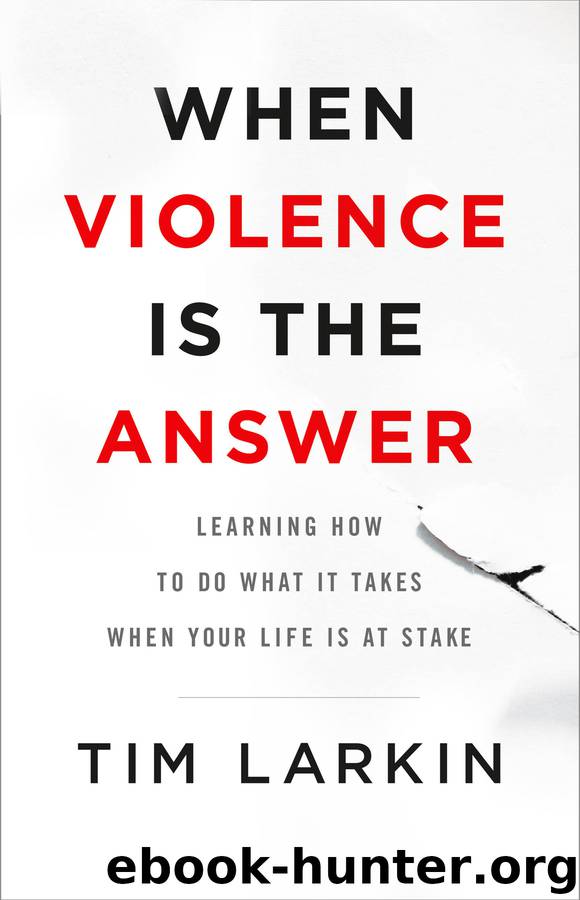When Violence Is the Answer: Learning How to Do What It Takes When Your Life Is at Stake by Larkin Tim

Author:Larkin, Tim [Larkin, Tim]
Language: eng
Format: epub
Publisher: Little, Brown and Company
Published: 2017-09-05T04:00:00+00:00
IF IT BREAKS, IT’S A TARGET
A target is an anatomical structure that can be crushed, ruptured, broken, or otherwise rendered useless, thereby rendering your opponent useless .
Full stop.
That is the definition of a target. Read it again. It’s simple, but there are some hard concepts and visceral images associated with the words in that definition. Reread them until they don’t make you wince, until they are simply facts. Equally as important as getting comfortable with this concept is becoming familiar with the characteristics of those targets that generalize across the human body. The more familiar you get with them, the faster you’re able to identify what you can get in the heat of the moment, and the easier it is to embrace what your job is once you do.
Targets are places that are critical to normal functioning. The eyes, the throat, the genitals, joints, motor nerves, just to name a few. These are the structures the body can’t do without if it’s going to run around and function at peak performance. You can punch someone in the stomach or kick them in the butt and it can be painful, but it won’t incapacitate the victim because the area of trauma is non-critical and non-specific. Some of these areas are more vulnerable than others, and require different angles or amounts of force, but they are all critical for normal human function—walking, breathing, seeing, grabbing things—which means they are critical to stopping your attacker.
Targets are the entry point for a vector of force. Most people imagine a target as a point, a circle or dot that could be drawn on the skin that means “hit here.” A target is not simply a dot on the skin around the critical, injury-prone area. It’s not the pointy part of the Adam’s apple or the round part of the kneecap or the iris of the eye.
This is really, really important. If you get nothing else from this section, remember this: a target is an aim-point through which you are going to visualize putting all your body weight, with the goal of creating an entry wound. And every decent entry wound has an exit wound, with a tunnel of wreckage between the two. This is what bullets do and it’s what you must visualize yourself doing (more on this later). You are going to throw yourself through the target, to make whatever tool you’re using come out the other side, whether it’s your thumb, like in Sara’s case, your boot heel, like with Bonnie, or your fist, like Jorge Orozco.
When you look at a target, your mindset should be biased toward action and your point of view should be set to a three-dimensional, vector-infested picture of your attacker’s anatomy. You should be looking into the future, through the tunnel of wreckage you are about to create, visualizing where your enemy has folded and broken from the injury you are about to inflict. Bonnie didn’t just hit the surface of her assailant’s kneecap, she struck it as
Download
This site does not store any files on its server. We only index and link to content provided by other sites. Please contact the content providers to delete copyright contents if any and email us, we'll remove relevant links or contents immediately.
| Anthropology | Archaeology |
| Philosophy | Politics & Government |
| Social Sciences | Sociology |
| Women's Studies |
Cecilia; Or, Memoirs of an Heiress — Volume 1 by Fanny Burney(32062)
Cecilia; Or, Memoirs of an Heiress — Volume 3 by Fanny Burney(31458)
Cecilia; Or, Memoirs of an Heiress — Volume 2 by Fanny Burney(31409)
The Great Music City by Andrea Baker(30781)
We're Going to Need More Wine by Gabrielle Union(18633)
All the Missing Girls by Megan Miranda(14737)
Pimp by Iceberg Slim(13779)
Bombshells: Glamour Girls of a Lifetime by Sullivan Steve(13685)
Fifty Shades Freed by E L James(12915)
Talking to Strangers by Malcolm Gladwell(12875)
Norse Mythology by Gaiman Neil(12828)
For the Love of Europe by Rick Steves(11476)
Crazy Rich Asians by Kevin Kwan(8888)
Mindhunter: Inside the FBI's Elite Serial Crime Unit by John E. Douglas & Mark Olshaker(8702)
The Lost Art of Listening by Michael P. Nichols(7160)
Enlightenment Now: The Case for Reason, Science, Humanism, and Progress by Steven Pinker(6874)
The Four Agreements by Don Miguel Ruiz(6319)
Bad Blood by John Carreyrou(6278)
Weapons of Math Destruction by Cathy O'Neil(5832)
